1993 BUICK PARK AVENUE engine coolant
[x] Cancel search: engine coolantPage 261 of 340
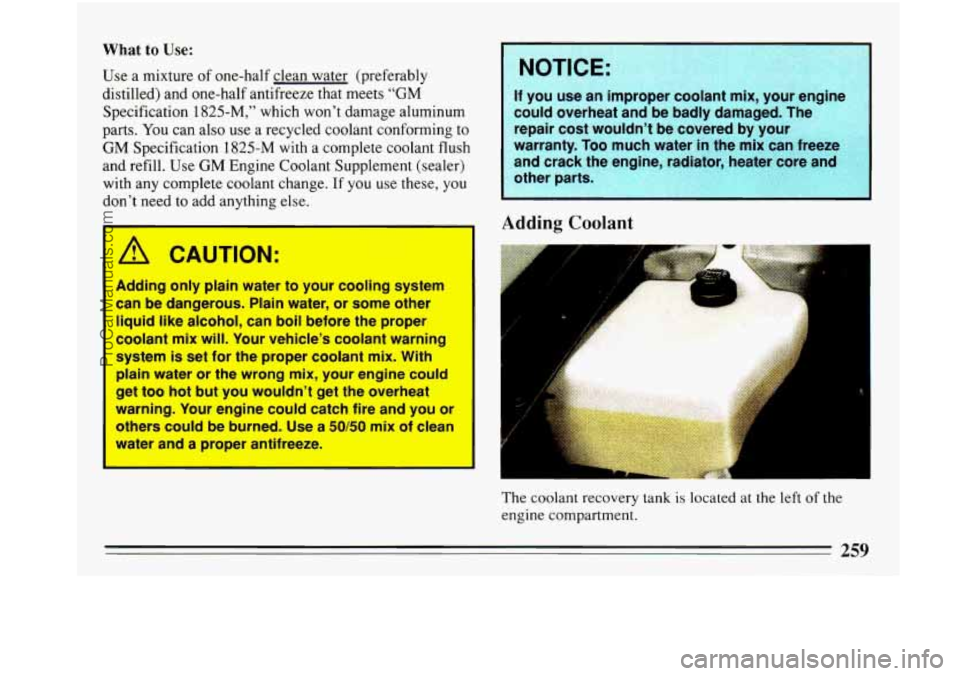
What to Use:
Use a mixture of one-half clean water (preferably
distilled) and one-half antifreeze that meets “GM
Specification
1825-M,” which won’t damage aluminum
parts.
You can also use a recycled coolant conforming to
GM Specification
1825-M with a complete coolant flush
and refill. Use GM Engine Coolant Supplement (sealer)
with any complete coolant change. If you use these, you
don’t need
to add anything else.
A CAUTION:
Adding only plain water to your cooling system
can be dangerous. Plain water, or some other
liquid like alcohol, can boil before the proper
coolant mix will. Your vehicle’s coolant warning
system
is set for the proper coolant mix. With
plain water or the wrong mix, your engine could
get too hot but you wouldn’t get the overheat
warning. Your engine could catch fire and you or
others could be burned. Use
a 50/50 mix of clean
water and a proper antifreeze.
If you use an improper coolant mix, your
engine :,,I could overheat and be badly damaged. The’: . -
repair cost wouldn’t be covered by your -.. - ’
warranty. Too much water in the mix can !ete;::
and crack the engine, radiator, heater
Core and
other parts.
~. -.- . ~. .. ..._ - . . :-: -. ~ . . ~.., -
Adding Coolant
6
The coolant recovery tank IS located at the left of the
engine compartment.
259
ProCarManuals.com
Page 262 of 340
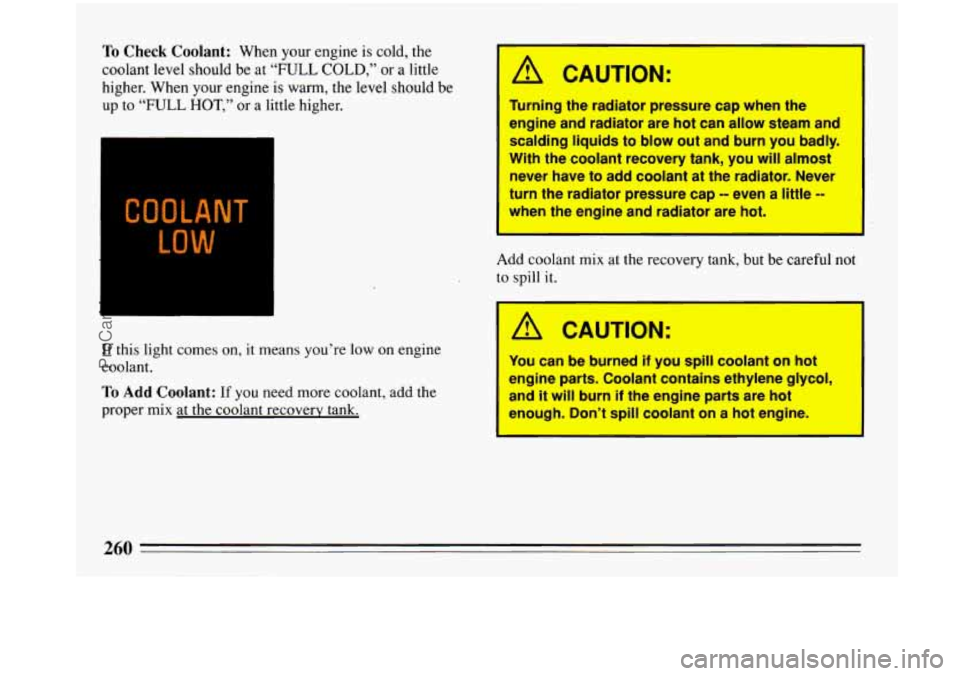
To Check Coolant: When your engine is cold, the
coolant level should be at
“FULL COLD,” or a little
higher. When your engine is warm, the level should be
up to
“FULL HOT,” or a little higher.
If this light comes
on, it means you’re low on engine
coolant.
To Add Coolant: If you need more coolant, add the
proper mix at the coolant recovery .tank.
‘ CAUTION:
T‘urning the radiator pressure cap when the
engine and radiator are hot can allow steam and
scalding liquids to blow out and burn you badly.
With the coolant recovery tank, you will almost
never have to add coolant at the radiator. Never
turn the radiator pressure cap -- even a little -
#hen the engine and radiator are hot.
I
Add coolant mix at the recovery tank, but be careful not
to spill it.
A CAUTION:
You can be burned if you spill coolant on hot
engine parts. Coolant contains ethylene glycol,
and it will burn
if the engine parts are hot
enough. Don’t spill coolant on a hot engine.
ProCarManuals.com
Page 263 of 340
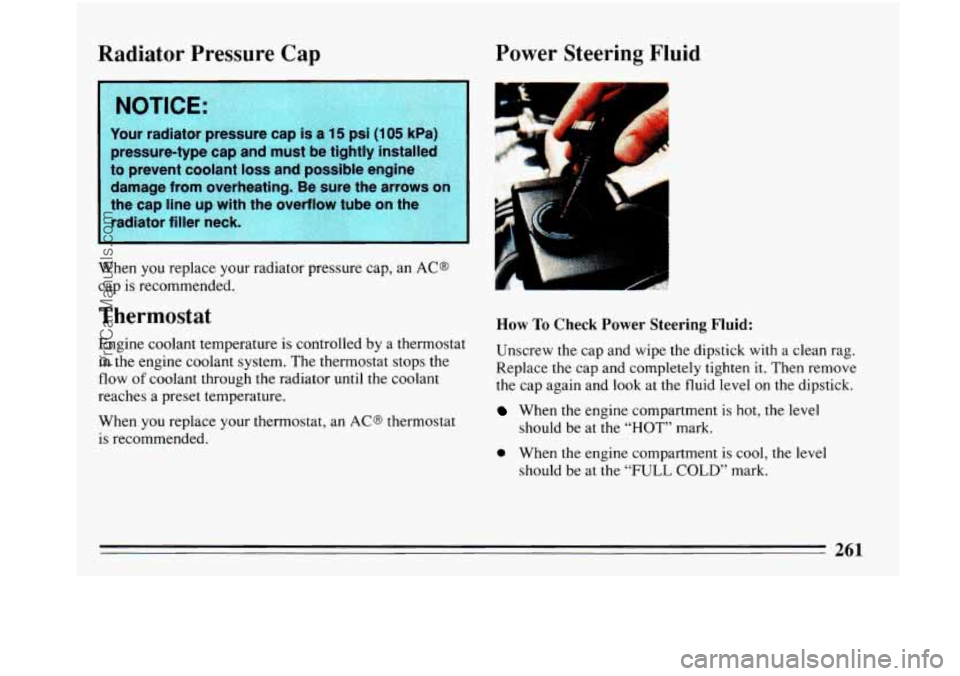
Radiator Pressure Cap
Your radiator pressure cap is a 15 psi (105 kPa)
pressure-type cap and must be tightly install
to prevent coolant
loss and possible engine
damage from overheating. Be sure the arro
the cap line up with the
ov be on t
radiator filler neck.
Power Steering Fluid
When you replace your radiator pressure cap, an AC@
cap
is recommended.
Thermostat
Engine coolant temperature is controlled by a thermostat
in the engine coolant system. The thermostat stops the
flow
of coolant through the radiator until the coolant
reaches a preset temperature.
When
you replace your thermostat, an AC@ thermostat
is recommended.
How To Check Power Steering Fluid:
Unscrew the cap and wipe the dipstick with a clean rag.
Replace
the cap and completely tighten it. Then remove
the cap again and look at the fluid level on the dipstick.
When the engine compartment is hot, the level
should be at the
“HOT” mark.
0 When the engine compartment is cool, the level
should be at the “FULL COLD” mark.
ProCarManuals.com
Page 304 of 340
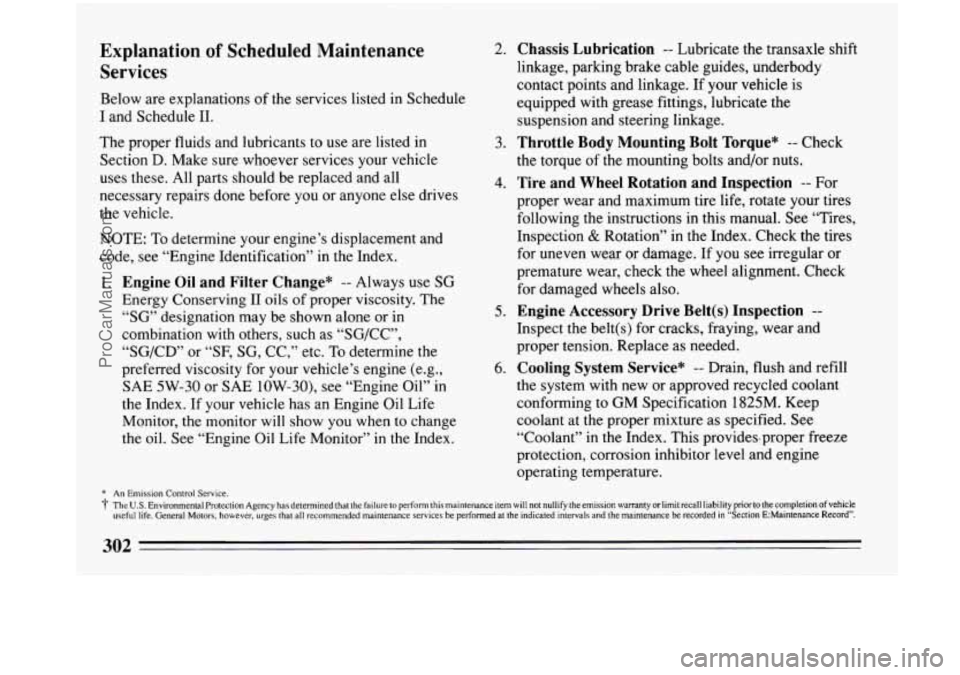
Explanation of Scheduled Maintenance
Services
Below are explanations of the services listed in Schedule
I and Schedule
11.
The proper fluids and lubricants to use are listed in
Section
D. Make sure whoever services your vehicle
uses these. All parts should be replaced and all
necessary repairs done before you or anyone else drives
the vehicle.
NOTE: To determine your engine’s displacement and
code, see “Engine Identification” in the Index.
1. Engine Oil and Filter Change* -- Always use SG
Energy Conserving I1 oils of proper viscosity. The
“SG” designation may be shown alone or in
combination with others, such as “SG/CC”,
“SG/CD” or
“SF, SG, CC,” etc. To determine the
preferred viscosity for your vehicle’s engine (e.g.,
SAE
5W-30 or SAE 10W-30), see “Engine Oil” in
the Index. If your vehicle has an Engine
Oil Life
Monitor,
the monitor will show you when to change
the oil. See “Engine Oil Life Monitor” in the Index.
* An Emission Control Service.
2.
3.
4.
5.
6.
Chassis Lubrication -- Lubricate the transaxle shift
linkage, parking brake cable guides, underbody
contact points and linkage. If your vehicle is
equipped with grease fittings, lubricate the
suspension and steering linkage.
Throttle Body Mounting Bolt Torque” -- Check
the torque
of the mounting bolts and/or nuts.
Tire and Wheel Rotation and Inspection -- For
proper wear and maximum tire life, rotate your tires
following the instructions in this manual. See “Tires,
Inspection
& Rotation” in the Index. Check the tires
for uneven wear or damage. If you see irregular or
premature wear, check the wheel alignment. Check
for damaged wheels also.
Engine Accessory Drive Belt(s) Inspection --
Inspect the belt(s) for cracks, fraying, wear and
proper tension. Replace as needed.
Cooling System Service* -- Drain, flush and refill
the system with new or approved recycled coolant
conforming to GM Specification
1825M. Keep
coolant at the proper mixture
as specified. See
“Coolant” in the Index. This provides.proper freeze
protection, corrosion inhibitor level and engine
operating temperature.
The U.S. Environmental Protection Agency has determined that the failure to perform this maintenance item will not nullify the emission warranty or limit recall liability prior to the completion of vehicle
useful life. General Motors, however, urges that all recommended maintenance services be performed at the indicated intervals and the maintenance be recorded in “Section E:Maintenance Record”.
302
ProCarManuals.com
Page 306 of 340
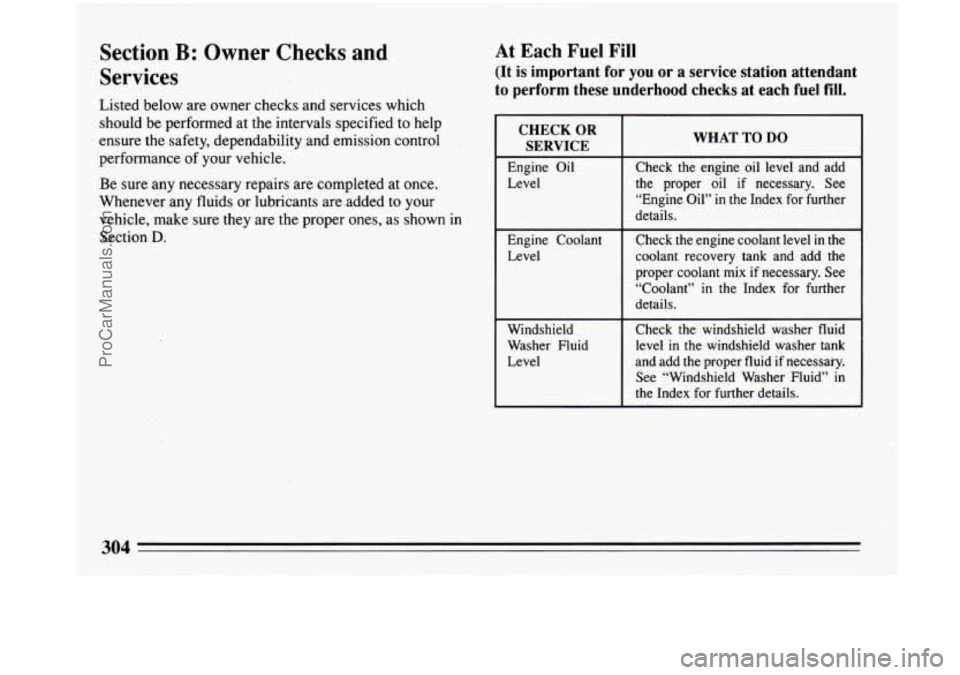
Section B: Owner Checks and
Services
Listed below are owner checks and services which
should be performed
at the intervals specified to help
ensure the safety, dependability and emission control
.
performance of your vehicle.
Be sure any necessary repairs are completed at once.
Whenever any fluids or lubricants are added to your
vehicle, make sure they are the proper ones, as shown
in
Section D.
At Each Fuel Fill
(It is important for you or a service station attendant
to perform these underhood checks at each fuel
fill.
CHECK OR
SERVICE
Engine Oil
Level
Engine Coolant
Level
Windshield
Washer Fluid Level
WHAT TO DO
Check the engine oil level and add
the proper oil if necessary. See
“Engine Oil”
in the Index for further
details.
Check the engine coolant level
in the
coolant recovery tank and add the
proper coolant mix
if necessary. See
“Coolant” in the Index
for further
details.
Check the windshield washer fluid
level in the windshield washer tank
and add the proper fluid
if necessary.
See “Windshield Washer Fluid” in
the Index for further details.
304
ProCarManuals.com
Page 311 of 340
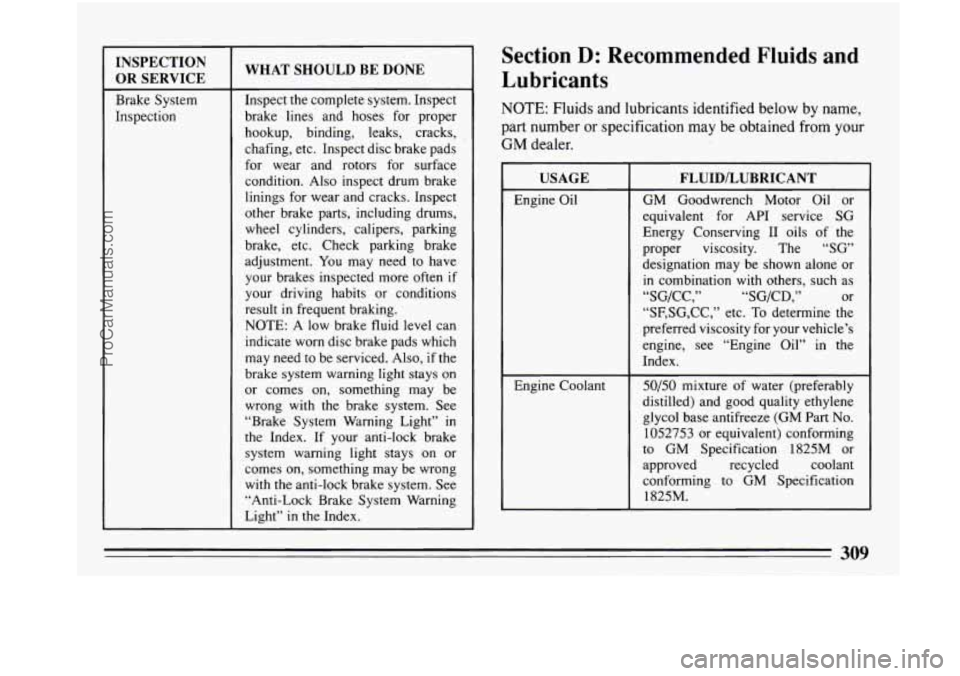
INSPECTION
OR SERVICE
Brake System
Inspection
WHAT SHOULD BE DONE
Inspect the complete system. Inspect
brake lines and hoses for proper
hookup, binding, leaks, cracks, chafing, etc. Inspect disc brake pads
for wear and rotors for surface
condition. Also inspect drum brake
linings for wear and cracks. Inspect
other brake parts, including drums,
wheel cylinders, calipers, parking
brake, etc. Check parking brake
adjustment.
You may need to have
your brakes inspected more often
if
your driving habits or conditions
result
in frequent braking.
NOTE: A low brake fluid level can
indicate worn disc brake pads which
may need
to be serviced. Also, if the
brake system warning light stays on
or comes
on, something may be
wrong with
the brake system. See
“Brake System Warning Light”
in
the Index. If your anti-lock brake
system warning light stays on or
comes on, something may be wrong
with
the anti-lock brake system. See
“Anti-Lock Brake System Warning
Light”
in the Index.
Section D: Recommended Fluids and
Lubricants
NOTE: Fluids and lubricants identified below by name,
part number or specification may be obtained from your
GM dealer.
USAGE
Engine Oil
Engine Coolant
FLUID/LUBRICANT
GM Goodwrench Motor Oil or
equivalent for API service SG
Energy Conserving I1 oils of the
proper viscosity. The
“SG”
designation may be shown alone or
in combination with others, such as
“SG/CC,” “SG/CD,”
or
“SF,SG,CC,” etc. To determine the
preferred viscosity for your vehicle’s
engine, see “Engine Oil” in the
Index.
50/50 mixture of water (preferably
distilled) and good quality ethylene
glycol base antifreeze (GM
Part No.
1052753 or equivalent) conforming
to GM Specification 1825M or
approved recycled coolant
conforming to GM Specification
1825M.
ProCarManuals.com
Page 323 of 340
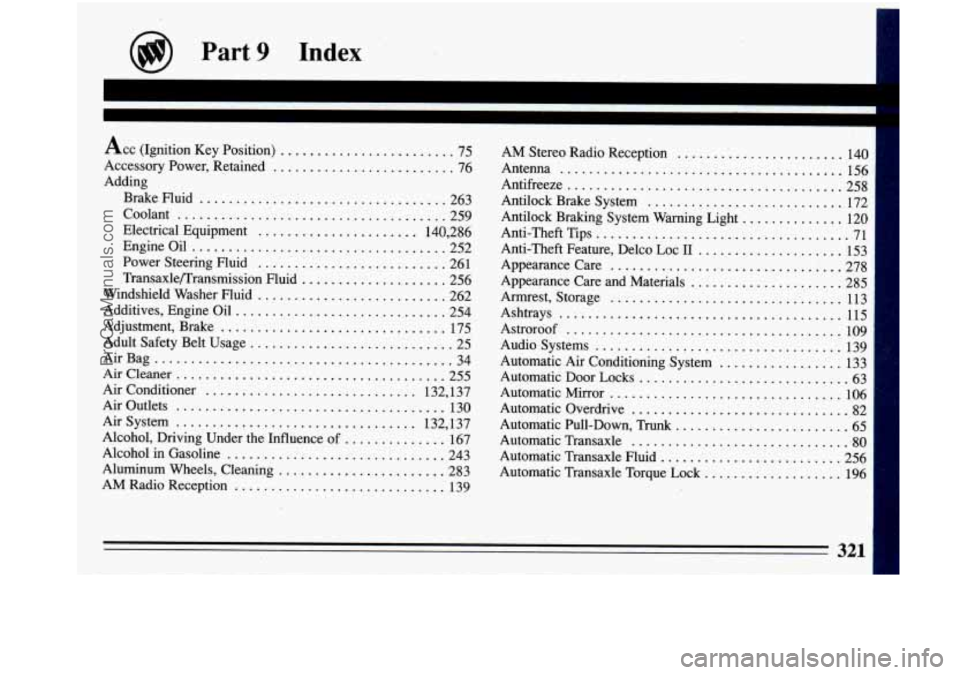
Part 9 Index
.
Ace (Ignition Key Position) ........................ 75
Accessory Power. Retained
......................... 76
Adding
Brake Fluid
.................................. 263
Coolant
..................................... 259
Electrical Equipment
...................... 140, 286
Engineoil
................................... 252
Power Steering Fluid
.......................... 261
Transaxle/Transmission Fluid
.................... 256
Windshield Washer Fluid
........................... 262
Additives, Engine Oil
............................. 254
Adjustment, Brake
............................... 175
Adult Safety Belt Usage
............................. 25
AirBag
.......................................... 34
Aircleaner
..................................... 255
Air Conditioner ............................. 132, 137
Air Outlets ..................................... 130
Air System
................................. 132, 137
Alcohol, Driving Under the Influence of
.............. 167
Alcohol
in Gasoline .............................. 243
Aluminum Wheels, Cleaning
....................... 283
AM Radio Reception ............................. 139 AM
Stereo Radio Reception
......................... 140
Antenna
....................................... 156
Antifreeze
...................................... 258
Antilock Brake System ........................... 172
Antilock Braking System Warning Light
.............. 120
Anti-TheftTips
................................... 71
Anti-Theft Feature, Delco LOC I1
.................... 153
Appearance Care
.................................. 278
Appearance Care and Materials
..................... 285
Armrest, Storage
................................ 113
Ashtrays
.. : ...................................... 115
Astroroof
...................................... 109
Audio Systems
.................................. 139
Automatic Air Conditioning System
................. 133
Automatic Door Locks
............................. 63
Automatic Mirror
................................ 106
Automatic Overdrive
.............................. 82
Automatic Pull-Down, Trunk
........................ 65
Automatic Transaxle
.............................. 80 I
Automatic Transaxle Fluid ......................... 256
Automatic Transaxle Torque Lock
................... 196
321
ProCarManuals.com
Page 324 of 340
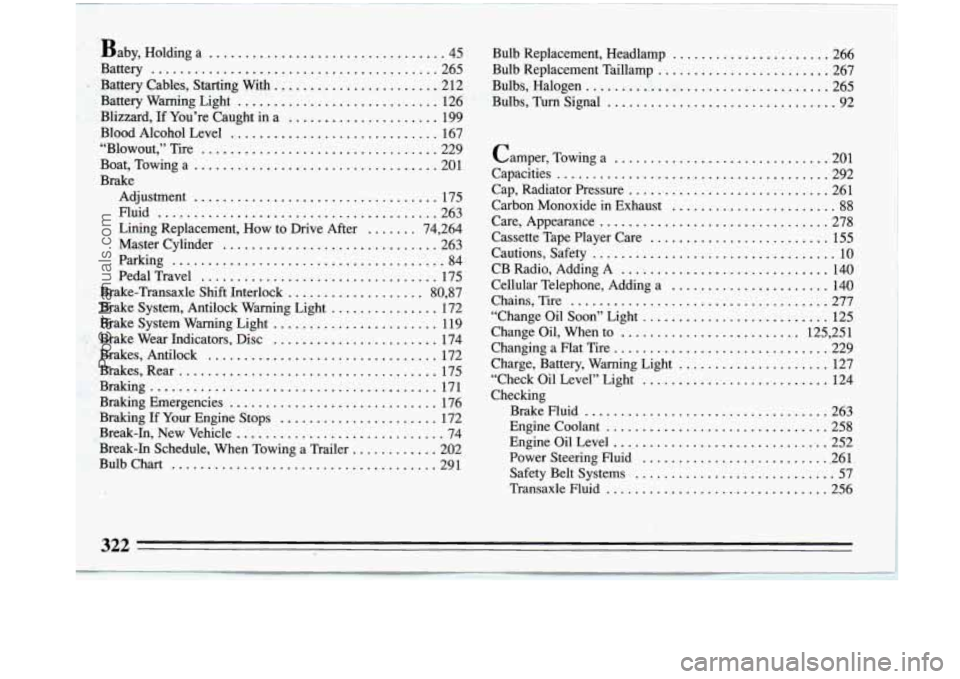
Baby. Holding a ................................. 45
Battery
........................................ 265
. Battery Cables, Starting With ....................... 212
Battery Warning Light
............................ 126
Blizzard,
If You’re Caught in a ..................... 199
Blood Alcohol Level
............................. 167
“Blowout,
” Tire ................................. 229
Boat, Towinga
.................................. 201
Brake
Adjustment
.................................. 175
Fluid
....................................... 263
Lining Replacement, How to Drive After
....... 74, 264
Master Cylinder
.............................. 263
Brake-Transaxle
Shift Interlock ................... 80, 87
Brake System, Antilock Warning Light
............... 172
Brake System Warning Light
....................... 119
Brake Wear Indicators,
Disc ....................... 174
Brakes, Antilock
................................ 172
Brakes, Rear
..................................... 175
Braking
........................................ 171
Braking Emergencies
............................. 176
Braking
If Your Engine Stops ...................... 172
Break-In, New Vehicle
............................ -74
Break-In Schedule, When Towing a Trailer
............ 202
Parking
...................................... 84
PedalTravel
................................. 175
Bulbchart
..................................... 291
Bulb Replacement. Headlamp ...................... 266
Bulb Replacement Taillamp
........................ 267
Bulbs. Halogen
.................................. 265
Bulbs. Turn Signal
................................ 92
camper. Towing a
.............................. 201
Capacities
...................................... 292
Cap. Radiator Pressure
............................ 261
Carbon Monoxide in Exhaust
....................... 88
Care. Appearance ................................ 278
Cassette Tape Player Care
......................... 155
Cautions. Safety
.................................. 10
CB Radio. Adding A
............................. 140
Cellular Telephone. Adding a
...................... 140
Chains. Tire
.................................... 277
“Change Oil Soon” Light
.......................... 125
Change Oil. When to
......................... 125. 251
Changing a Flat Tire
.............................. 229
Charge. Battery. Warning Light
..................... 127
“Check Oil Level” Light
.......................... 124
Engine Coolant
............................... 258
Engine Oil Level ............................... 252
Power Steering Fluid
.......................... .26 1.
Safety Belt Systems ............................ 57
Transaxle Fluid
............................... 256
Checking
BrakeFluid
.................................. 263
322
ProCarManuals.com